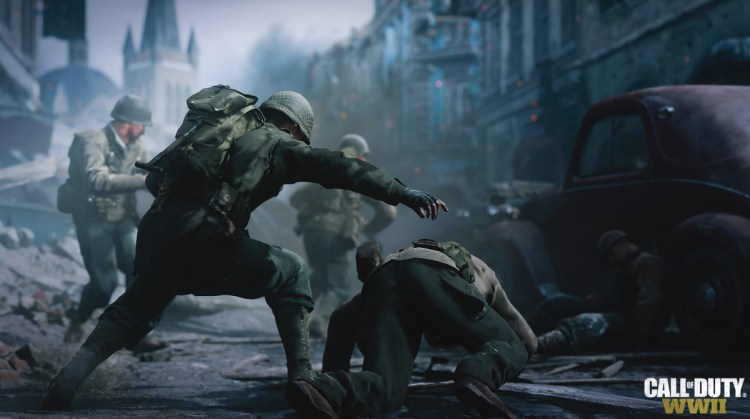Glen Schofield and Michael Condrey feel like Call of Duty: WWII is a personal passion project for the employees in their studio. Sledgehammer Games is making this year’s Call of Duty game, and they’re taking it back to its roots in the Second World War.
In the single-player campaign revealed today, you’ll play as soldiers in a squad in the U.S. Army’s 1st Infantry Division, known as The Big Red One or The Fighting First. The division saw a lot of action throughout the war, starting in North Africa in Tunisia. It moved on to Sicily, Normandy, Aachen, and the Ardennes, the site of the Battle of the Bulge.
It felt personal to Schofield because his grandfather was a decorated veteran who won a Purple Heart medal while part of the 34th Infantry Division. Condrey and Schofield visited battlefields in Europe, such as the freezing Hürtgen Forest in Germany to the beaches of Normandy in France. From that, they developed a huge amount of respect for the sacrifices made by ordinary soldiers on all sides, Condrey said. And many of those veterans are no longer around to tell their stories in a truthful, unvarnished way.
June 5th: The AI Audit in NYC
Join us next week in NYC to engage with top executive leaders, delving into strategies for auditing AI models to ensure fairness, optimal performance, and ethical compliance across diverse organizations. Secure your attendance for this exclusive invite-only event.
Sledgehammer set out to make a fun first-person shooter, but it will tell the story from the eyes of a squad of ordinary grunts. They will run into situations that expose the dark side the war as well as the diversity of the combatants, including the exploits of African-American soldiers and women leading the French Resistance.
“To make sure this story is told and heard—it’s time for us to retell it. That’s a huge honor,” said Condrey.
Both Condrey and Schofield will speak at our upcoming GamesBeat Summit event on May 1-2 in Berkeley, California. Here’s an edited transcript of our interview.

Above: Sledgehammer Games cofounders Glen Schofield (left) and Michael Condrey.
GamesBeat: You were saying this was personal. You were researching your grandfather?
Glen Schofield: Yeah, that’s where I started. We had the meeting where we decided to do WWII and we’re all high-fiving. Then we think, “Oh shit, what part?” Everybody had their own place where they started to research. It was just a few of us. But that’s where I started. We wrapped back to Normandy. We didn’t want to shy away from that.
GamesBeat: What did you pull out of that research?
Schofield: We all got, very early on, as we were doing this—the word is “respect.” I only knew him until I was 12 or so, but I would have never known he was a hero. He never talked about it. As a matter of fact, my father never even mentioned him getting a Purple Heart until I saw this two and a half years ago, or the Bronze Star. It’s just a different generation. Nowadays you’d hear about it. They were very humble. That, I think, is what I got out of it.
Michael Condrey: I find that’s the most powerful thing about the people we’ve heard from, family members that tell their stories. There was a story of a man who landed on D-Day. He was hit three times before he made it up the beach. He was shot in the jaw, and then he stepped on a mine, and then he got shot in the shoulder. He made it across the beach, which took about 12 hours, and he didn’t describe himself as a “hero.” Doesn’t consider himself heroic. He talks about the men who fell as the heroes. He talked about everyone else in terms of heroism, but not himself. It’s remarkable. It was a different era.
GamesBeat: It’s a lot different from going into a game expecting you to take out 45 people in the first level.
Condrey: In Modern Warfare 3 you’re a tier one operator, the best of the best. In Advanced Warfare you’re the tier one operator of the future. Those were great stories to tell, but this is different. This is about the common man and the camaraderie of a squad, how they came together to persevere. It’s a different motivation.
GamesBeat: I was talking to one of your other staff about how you’re re-creating an experience, more so than playing a game.
Schofield: I hope so, yeah. Playing a game—we’ve discussed this a lot. To me, a game is a toy. What we’re creating is art. “Game” doesn’t feel deep enough for what we make nowadays. They used to be more and more game-like. Now they’re story-driven, emotion-driven, all sorts of things. It’s an evolution of the art.

Above: Vehicles make a lot of noise in Call of Duty: WWII.
GamesBeat: But it’s still very interactive.
Schofield: That’s the key to this one. We want to put you—the difference between, say, storming the beach in an earlier game and storming the beach in this game is that we can really make you feel like you’re there. With bigger 4K screens now and better sound systems, everything is working together to make this thing put you in the boots there. I hate to use the obvious terms, but that’s what we’re trying to do.
GamesBeat: And you’re aiming this at an audience that isn’t as familiar with the history?
Schofield: I hope you, who have experienced this and played these games before—the idea is that we make games for ourselves. We’ve all experienced that. We said, “Okay, what I want to do in a new game, since I’ve played all of these before? How do I want to make it more immersive?” What we wanted to do is make it more realistic, like you’re really there.
Condrey: I think of Force Awakens. For me, who grew up as a Star Wars fan, it was powerful to come back to that. If a viewer is having their first Star Wars experience, it’s a great film as well. Whether this is your first Call of Duty WWII experience, or the first one you’ve played in 10 years, we hope it’s an emotionally powerful new way to play, a new narrative, an experience you haven’t had in a long time.
GamesBeat: Your talk at the GamesBeat Summit is about inspiring creativity. What was it like doing that with your team, inspiring them to work on another Call of Duty and another WWII game?
Schofield: I’ve thought about this a lot since my career took me over to the creative side. These days, with ideas—you can go home nowadays and say, “Okay, I’ll come up with that idea in two days. I got that.” You have to find a way to have ideas all the time, or how to inspire them, because every day is 100 new ideas. Some of them are tiny. Some of them are giant mechanics. We have to make sure we get our team thinking about being creative and thinking differently, thinking deeper.
A lot of times it takes an example from us. We were trying to think of a new beginning a year and a half ago. Maybe we can do this, maybe we can do that. One of us said, “Why don’t you take the eleventh level and put it in the beginning?” It wasn’t that that was the example, but it got them thinking, “Oh, wow, we can go that far? Good.” That’s what we do all the time. We have to always be getting people excited and inspired.
One of the guys came to me yesterday. We had a meeting about his level a couple of days earlier, with a new team, and they were so excited by it. Yesterday they came to me and they wanted to pitch me this new little part that they wanted to add. That was powerful. I’d much rather do that than be the guy saying, “This is my idea.” It’s fun to discover these ideas now. That’s our job.
GamesBeat: But you do eventually have to ship the game.
Schofield: We have 300 people who are all creative. You guys come up with these ideas. You guys come up with those ideas. You can’t ever come up with enough. These games are so gigantic now.
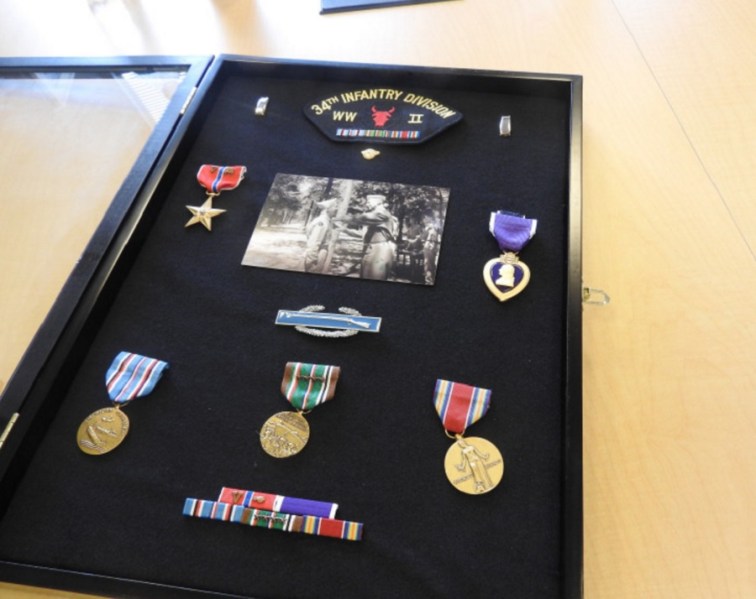
Above: Glen Schofield’s grandfather was in the 34th Infantry Division and earned a Purple Heart.
GamesBeat: With three-year cadence for Call of Duty, are you getting into a groove now that you have a couple of projects behind you?
Condrey: Your ambitions scale. The industry is so dynamic and so exciting that the extra time gives you more opportunities to think in pre-production about what you want to do. It also gives you more time to react to what fans want. But it never seems to translate to feeling like we’re more efficient or more on time. It’s always going 100 miles an hour. Certainly I can’t imagine going back to the days when we turned a game around in 18 months.
Schofield: We couldn’t make this in any less time. But the second year is a slog, for me. The first year is exciting. We’re getting the new ideas in pre-production. The second year, you’re about a year away from when it really starts coming together. That’s a long, long time. I’m glad that’s behind us. But we accomplished so much. Now, seeing the game—we do get efficient near the end. Right now, the next six months—
Condrey: We’ll move mountains.
Schofield: This is when everyone knows their levels. They know what they’re doing. They’re putting the little tiny details in. We call them the happy surprises, the happy accidents they leave in there. “That’s a great detail!”
Condrey: It’s also great when you get to the point where you can finally share it with fans. It’s the thing I miss the most about the three-year cycle, the moment when fans get to celebrate with you. It’s great to have the reveal right around the corner.
Schofield: Three years is a long time, but we couldn’t do it any other way now. You’d have to have a team so big that it’s unwieldy.
GamesBeat: Do the fans guide you in some way? Science fiction maybe wasn’t as broadly cheered by the fans. Battlefield’s return to WWI seemed like a popular idea. Did that make the decision to focus on WWII feel better?
Schofield: I know for the two of us, once we make a decision, we usually don’t look back. In this case, we just moved forward. It felt absolutely right. There’s never been a regret about not making AW2 or anything like that. We felt like this was the right one to make. Creatively it was a nice challenge for us. We didn’t want to do rinse and repeat again.
Condrey: We made this shift long before we knew anything about Dunkirk or any other interactive entertainment or linear entertainment was talking about WWII. We look at it now and it feels like the next 24 months is going to be a sort of resurgence for WWII in different entertainment spaces. We’re excited to be there.
Schofield: Not that we got lucky, but—on the last game, the exo-suit, that was in Elysium. That was in Edge of Tomorrow. It was in the cultural consciousness. All of a sudden, after that, we were kind of burnt out on it and we wanted to go back to this. It feels like maybe the same thing was happening elsewhere.
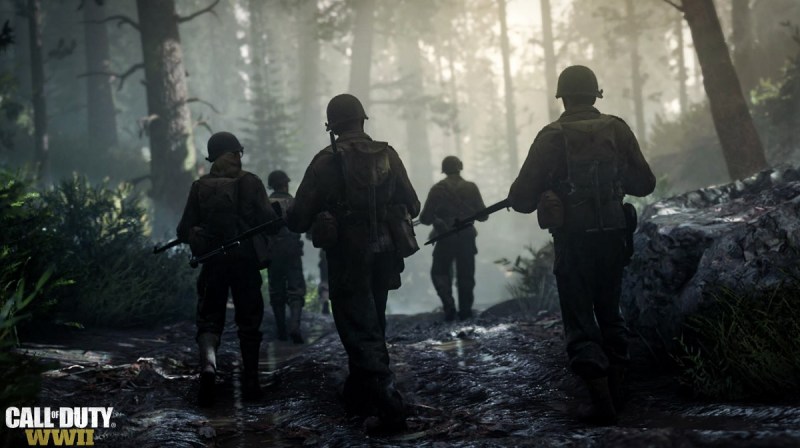
Above: You are part of a squad in the 1st Infantry Division in Call of Duty: WWII.
GamesBeat: It’s a cycle that leads to creative exhaustion and then you get a reboot or a retelling that makes sense.
Schofield: It happens a lot. Rom-coms all seem to come out at once. You do have these cycles.
Condrey: There’s probably two answers to the question. One, we made this decision long before any other big entertainment property was talking about WWII. But we do listen to fans, obviously. Coming out of MW3, fans were demanding innovation. Advanced Warfare was the result of that. Coming out of Advanced Warfare, we saw the opportunity to have a return to the roots that fans were excited about. So both of those were true. We made the decision a long time ago, and it’s exciting to be back now that WWII is back in the zeitgeist.
Schofield: There’s a validation to it. That’s awesome to feel.
Condrey: And the fans definitely help us, too.
Schofield: They seemed pretty excited just when the words “boots on the ground” came out.
GamesBeat: Diversity has a different value these days in games.
Schofield: Completely.
GamesBeat: Battlefield 1 woman as a lead character in a pretty big role. You didn’t expect that in a historical setting. But you have a more diverse scope than past Call of Duty games have had. What’s some of the thinking there?
Condrey: You and I have talked about this before. Our games are better when we have a diverse work force. They’re better when we have a diverse fan base. We want to give people heroes that they can look up to and be inspired by. It’s an important part of Sledgehammer’s value set. We spent a lot of time researching throughout the war, about all kinds of heroes. Men and women—women played many, many roles, from resistance fighters to the Wasps to people in the workforce at home. People of all races. We want to celebrate all the heroes in the allied cause.
Schofield: It’s funny. People have a view of this as, “Wow, it was just all fighting men, right?” I think a lot of that comes from old movies, Big Red One and all that. As we study, we’re thinking, “This war would not have been won without women in the French resistance, women in Poland, women in factories in the United States turning out thousands of Sherman tanks.” It was remarkable for us, though, to see just how many women were actually on the front lines, fighting for different countries.
Condrey: You’ll see that all across the game. In every mode of the game, you can play as heroic women. We have gender and racial diversity throughout.
Schofield: Now, we don’t sugarcoat that part all the time, either. We talk about the African-American platoon. We talk about some of the struggles they go through. That’s not the sole point of the story, but—one of our key characters is Jewish. He didn’t just skate through the world. They gave him some shit. We touch on that as well. It’s not for controversy’s sake. It’s just that that’s the way the world was. Sugarcoating it, going the other way, would be wrong.
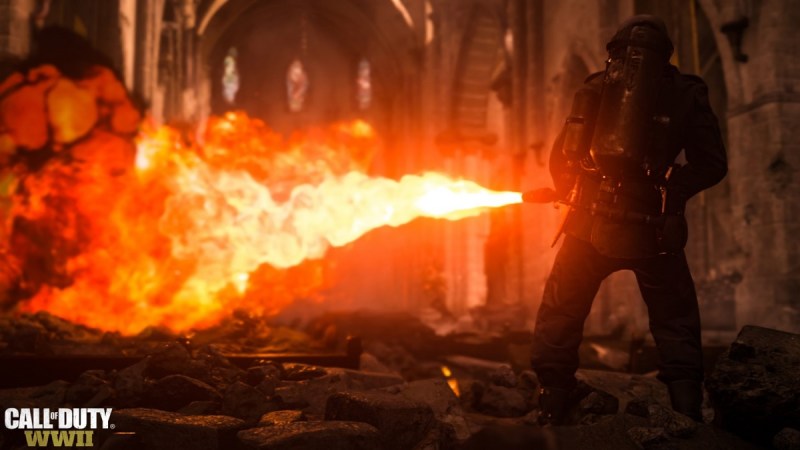
Above: Flamethrower in Call of Duty: WWII
GamesBeat: What sort of story did you feel would be your best option for your lead character? I assume it’s a single character you’re following?
Schofield: It’s a platoon.
Condrey: A squad of the 1st Infantry. A squad is usually about 12 men. It rests on Daniels and his best friend and the journey as their squad as they fight across the European theater of war.
Schofield: Each of the five characters that we really push on are—they come back. Let’s use Private Ryan as an example. You have the Italian dude with the mustache. You have Barry Pepper. They’re all characters. That’s what we loved about that movie, right? Those great characters fighting for one another. When one of them got killed or hurt, that was the emotional part. What we try to do here is to give you that connection, the same connection to the characters as you would in a movie, and make sure that each one felt like they had their own voice.
Condrey: I remember we were going through a pre-production exercise, talking about the personal journey that these soldiers would go through in the war. For some people, they enlisted in June of 1944, and a little over a year later they were out of the war. When you see their faces they look like they’ve aged 10 years. The experience put these young men in some harrowing experiences. They grew up quick. Our story tells that, tells the personal story of the squad, the complexities and camaraderie as the squad goes from the English Channel to the liberation of western Europe. But along the way you experience it through a couple of other points of view. We’ll leave that for players to see for themselves.
GamesBeat: There are some hints that you can play a lot of different types of sides in the war. Do you allow people to play on the German side? Is that something you have to grapple with in some way?
Condrey: Specifically in multiplayer—
Schofield: It’s a tough one.
Condrey: Call of Duty multiplayer has always rested on having two factions, two known factions, in this case the Allies and the Axis. The Axis were primarily Germans in Europe. You’ll play as an Axis character in multiplayer. Again, we’re not shying away from that, but we’re also not celebrating that. We don’t want to encourage any like-minded behaviors that would be toxic to our community.
Schofield: We also make a distinction between the SS and the German regular army. We have a moment in the game, an important moment, where a German soldier helps you. Later on you’re trying to rescue a German family, a mother and her daughters. You don’t want to see them hurt. There’s a humanity that we read about a lot that we wanted to get in there. We didn’t want to portray people purely as monsters.
GamesBeat: If you’re doing something more immersive, if you have this intention of respect, does that help you be more honest about that, going into these areas that have some taboo about them?
Schofield: It’s a north star for us. We’re going to be respectful. We’re going to tell the story. It’s a direction for us to follow. It’s the same with any of our games. We always have that north star that tells us where we’re going.
Condrey: It’s a delicate balance that the team embraced. Out of respect, you can’t shy away from some of these issues. Out of respect, you can’t focus on them in a way that feels wrong either. We do touch on some powerful topics, the realities of what happened in the ‘40s in North America, and the atrocities that happened in WWII. But always through that lens of respect and getting it right.
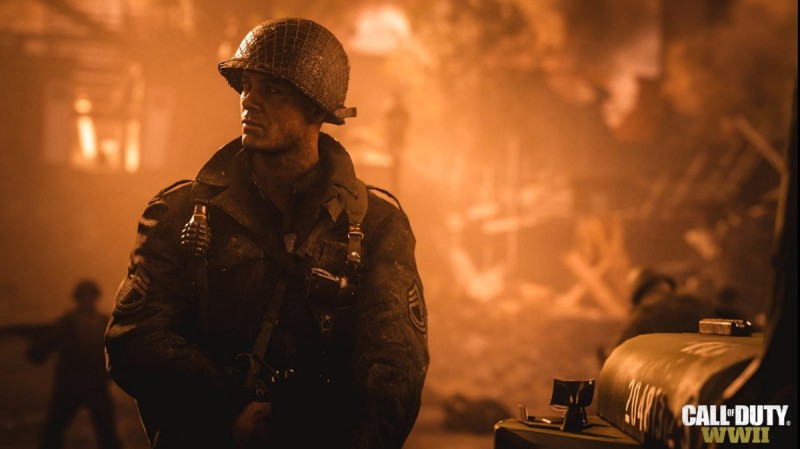
Above: Call of Duty: WWII has stark imagery.
GamesBeat: You did a lot of traveling, right? I think you said you went to the Reichstag?
Condrey: Yeah, we did. We’ve been all over the globe. We’ve been from Normandy to Gibraltar to Germany to Belgium. We’ve been across North America. We’ve sat in foxholes and Sherman tanks. We’ve driven half-tracks. You name it. We were in the Hurtgen forest at Hill 140.
Schofield: We set some of the combat in the woods. Guys are hiding behind trees, and it just didn’t feel right. There isn’t a lot of photos or film of combat in the woods. So we went out to these forests and we realized—the woods are full of trees fallen over. Guys were crawling and climbing all around. We went to places that you wouldn’t think we’d need to, but you really have to study some of this stuff to get what it was like. You don’t just have guys peeking their heads around trees. One soldier was telling me, if a German hid behind a tree I just put a bullet through the tree.
Condrey: We had this really remarkable trip just a couple of months ago. Europe was going through a pretty historic winter this last February. Glen and I were there, going from Luxembourg to Belgium up into Germany. There’s eight feet of snow in the ground, it’s zero degrees, and we’re standing in an original foxhole, the dug-out foxholes of 101st on the edge of Hürtgen Forest in the freezing cold. It gives you a profound respect for the conditions these battles happened in. It was powerful. We were out there in really high-end Tahoe ski gear, too, freezing to death. They were living in these holes. We’d run back to the van, huddle up, get some coffee.
Schofield: There’s still stuff there they carved into the trees. We found barbed wire still wrapped around the trees. And to see the hundreds of miles they put down the dragon’s teeth—here’s a crazy little story. We’re in the middle of nowhere. I’d swear we hadn’t seen a car in an hour. It’s snowing like crazy. Zero degrees. We pull over in these giant woods and there’s a little road. We stop and look around, looking at foxholes and stuff, and 10 minutes later we go back to see there’s someone by our car. We’re getting a parking ticket. “You’re blocking a fire road.” There’s four feet of snow!
Condrey: We saw Patton’s grave in Luxembourg. The list of places we’ve gone—this much, and we’ve only scratched the surface. The conflict was so massive, across so much of western Europe—both the history and just the physical battles—
Schofield: Have you ever been to Luxembourg?
GamesBeat: No, haven’t been.
Schofield: We hadn’t either, right? You wonder why the Germans didn’t just bounce in and take over Luxembourg. But you don’t realize until you get there that Luxembourg is mountainous. Crazy mountains. There’s no way you could get tanks through there. The Germans just left it alone. It was important for us to go to these places and realize things like that.
The interesting thing about Hurtgen Forest is it’s old growth. But mixed in, there’s a lot of new growth. So many trees were blown apart that we were seeing these big patches of 60-year-old trees mixed in with the huge 150-year-old ones.
Condrey: We stood by the first V2 rocket, which is really where the space age was invented, at that first launch site. We saw the internment camps outside Berlin. We really tried to go deep. And the deeper you go—through reading books and watching documentaries, going to museums as well–you pick up this profound sense of obligation to the story. We don’t want to trivialize it through our fictional version. We want to capture what it meant at the time. That’s where it becomes most personal to me.
Schofield: Not only that, but—remember when we were up in Bastogne? It was snowing there too. In Bastogne and other places they have monuments everywhere. We saw one monument after another to the Allies, thanking the Americans and thanking the other nations. We’d see tanks everywhere, where they just left them where they were and built a little park around it or whatever. We found one in the middle of nowhere, this giant Tiger tank that they just couldn’t move. I forget how many tons it was, but they couldn’t get it out of there, so they turned it into a monument. There are remnants of the war everywhere.
GamesBeat: Has the historian Marty Morgan been useful to you?
Condrey: Marty’s been phenomenal. He has a great history. You can look him up.
Schofield: He speaks all the different languages.
Condrey: He’s traveled throughout Europe and the Pacific doing academic tours. He’s the military historian for the WWII museum in Orleans. He was the military historian for Band of Brothers. He’s taught us so much.
Schofield: He doesn’t stop. It’s funny. We were seven or eight days in a van, the four of us, when we went on this one trip, and at some point I said, “Marty, I can’t take in anymore.” He’s so knowledgeable. What we’d do is just make sure that everything we did, it happened.
Condrey: It’s all based on real events. He’s still with us, by the way. I emailed him this morning looking for details about a certain regiment.
GamesBeat: Was there a process of pitching this upward to Activision?
Schofield: I have to say about Activision, they understand the creative motivation. They’re almost fanatical about us being passionate about the game we’re making. If they can sense we’re not passionate about it, they’ll say, “Okay, what is it?” It starts with Eric Hirshberg and some of those guys. They saw the passion we came back with and they were absolutely behind it. They wanted WWII anyway, but they didn’t want to try and force us, which I do appreciate. I’ve been in places where I’ve been forced to go there, and I don’t like it.
GamesBeat: It seems like the drift of history has been toward presenting something that’s less about nationalism and more about the individual experience.
Schofield: It’s a human war. It wasn’t just an American war.
GamesBeat: It’s interesting that you can use a game to tell a clearer version of history.
Condrey: And to tell a history that I think is fading from the eyes and minds of most of our generation. If you think about it, 75 years, that’s three generations. Grandfathers of today were born after the war. To make sure this story is told and heard—it’s time for us to retell it. That’s a huge honor.
GamesBeat: It seems like you guys found a mission in that and you stuck with it
Condrey: The reality of a three-year development cycle is you can’t expect to know, with 100 percent certainty, exactly where you’ll go between when you start and when you end. Nor should you. That’s the fastest way to make a derivative experience. You have to have time to fail and learn and explore and innovate and watch what’s happening with the fan reaction. We’ve certainly gone through that process, that the best creative companies go through, to get where we are today. But as far as wanting to deliver on an emotionally powerful narrative for WWII, a gritty and gripping depiction of the greatest conflict in human history, yeah. That was where we started two and a half years ago. It’s remarkable. It’s great to finally be able to talk about it.
Schofield: That was a real mouthful of adjectives. In a good way!
